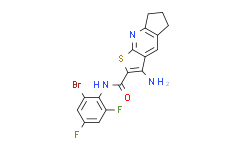| Cas No.: | 497061-48-0 |
| Chemical Name: | 3-amino-N-(2-bromo-4,6-difluorophenyl)-6,7-dihydro-5H-cyclopenta[b]thieno[3,2-e]pyridine-2-carboxamide |
| Synonyms: | 3-amino-N-(2-bromo-4,6-difluorophenyl)-6,7-dihydro-5H-cyclopenta[b]thieno[3,2-e]pyridine-2-carboxamide;3-Amino-N-(2-bromo-4,6-difluorophenyl)-6,7-dihydro-5H-cyclopenta[b]thieno[3,2-e]pyridine-2-carboxamide |
| SMILES: | FC1=CC(F)=C(NC(C2SC3=NC4CCCC=4C=C3C=2N)=O)C(Br)=C1 |
| Formula: | C17H12BrF2N3Os |
| M.Wt: | 424.262488365173 |
| Purity: | >98% |
| Sotrage: | 2 years -20°C Powder, 2 weeks 4°C in DMSO, 6 months -80°C in DMSO |
| Description: | DC_AC50 is a dual inhibitor of Atox1 and CCS (copper chaperones). Inhibiting intracellular copper chaperones as a means of reducing/preventing acquired chemotherapy resistance[1]. |
| In Vitro: | DC_AC50 exhibits IC50 values of 9.88 μM, 12.57 μM, 5.96 μM and 6.68 μM in Canine Abrams, Canine D1, human HOS and human MG63) cells, respectively[1]. DC_AC50 (0-10 μM)-treated cells are significantly less mitotically active, as demonstrated by decreased expression of phospho-histone H3 and cell cycle analysis[1]. DC_AC50 (10 μM) potentiates carboplatin-induced apoptosis in OSA cells and decreasesclonogenic survival[1]. DC_AC50 induces cell cycle arrest at both the 3 and 10 μM doses and DC_AC50 induces increase S phase cells dose-independently[1]. DC_AC50 (3 μM) inhibits the migration and of canine and human OSA cells[1]. DC_AC50 (2.5-10 μM) is highly efficient at inhibiting cancer cell proliferation (human lung cancer H1299 cells, leukaemia cancer K562 cells, breast cancer MDA-MB-231 cells and head and neck cancer 212LN cells) in a dose-dependent manner. DC_AC50 fails to exhibit any notable inhibition of the cell proliferation of human normal epithelial lung BEAS-2B cells or breast MCF-10A cells as control cells[2]. Cell Viability Assay[1] Cell Line: Canine OSA (Abrams, D1 and human OSA (HOS, MG63) cells. Concentration: 0-10 μM. Incubation Time: 72 h. Result: Dose-dependently decreased viability of OSA cells. Apoptosis Analysis[1] Cell Line: Abrams and HOS cells. Concentration: 1, 3 and 10 μM (10 μM Carboplatin). Incubation Time: 24 h. Result: Potentiated carboplatin-induced apoptosis. |
| References: | [1]. Jordon M Inkol, et al. Inhibition of copper chaperones sensitizes human and canine osteosarcoma cells to carboplatin chemotherapy. Vet Comp Oncol. 2020 Dec;18(4):559-569. [2]. Jing Wang, et al. Inhibition of human copper trafficking by a small molecule significantly attenuates cancer cell proliferation. Nat Chem. 2015 Dec;7(12):968-79. |

 To enhance service speed and avoid tariff delays, we've opened a US warehouse. All US orders ship directly from our US facility.
To enhance service speed and avoid tariff delays, we've opened a US warehouse. All US orders ship directly from our US facility.




















